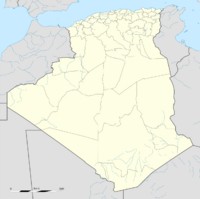Physics:Es-Salam nuclear reactor
| Es-Salam research reactor | |
|---|---|
| Operating Institution | Centre de Recherche Nucléaire de Birine (CRNB) |
| Location | Birine, Algeria |
| Coordinates | [ ⚑ ] 35°38′N 3°13′E / 35.63°N 3.22°E |
| Type | Heavy water reactor |
| Power | 15 MWt |
| Construction and Upkeep | |
| Construction Began | 1988-01-01 |
| First Criticality | 1992-02-17 |
| Technical Specifications | |
| Cooling | Heavy water |
| Neutron Moderator | Heavy water |
| Neutron Reflector | Graphite |
The Es-Salam research reactor, also known as the Aïn Oussara nuclear reactor is a nuclear research reactor in Algeria. The reactor can produce 15 megawatts-thermal and its primary uses are radiopharmaceutical production, neutron activation analysis, neutron radiography, and training.[1] The reactor was supplied by China and built in the region of Aïn Oussera, nearly due south of the capital city of Algiers. It reached criticality in February 1992 and began operation in late 1993.[1][2]
Es-Salam is a heavy-water reactor that uses low enriched uranium, with 3% enriched uranium oxide fuel.[2][3] In the early 1990s, there was fear among American intelligence agencies that the reactor could be used for nuclear proliferation, in part due to its location near a Soviet-supplied surface-to-air missile battery and the fact that the country had not yet ratified the Treaty on the Non-Proliferation of Nuclear Weapons (NPT).[4] At the time, the Algerian Ambassador to the United States, Abderrahmane Bensid, called the reactor's protections "normal, not extraordinary".[5] Information leaked from the CIA alleged that the reactor could be used for military purposes, and that the reactor could produce enough plutonium to produce a nuclear weapon within a year or two.[4]
In 1992, Algeria allowed International Atomic Energy Agency (IAEA) the ability to inspect the reactor, and the country eventually ratified the NPT in 1995 as a non-nuclear weapons State.[6][7] Algeria is also party to the Pelindaba treaty, which establishes a nuclear-weapon-free zone across the African continent.[8]
In 2019, the reactor was upgraded by the China National Nuclear Corporation (CNNC) to modernize equipment and extend its lifetime.[2]
See also
- Energy in Algeria
- NUR Reactor
- Research reactor
- List of nuclear research reactors
- Nuclear power in China
References
- ↑ Jump up to: 1.0 1.1 "RRDB". https://nucleus.iaea.org/rrdb/#/reactor/general-information.
- ↑ Jump up to: 2.0 2.1 2.2 "Algerian research reactor restarts after upgrades – Nuclear Engineering International". https://www.neimagazine.com/news/newsalgerian-research-reactor-restarts-after-upgrades-7008446.
- ↑ "Algeria Overview" (in en). https://www.nti.org/analysis/articles/algeria-overview/.
- ↑ Jump up to: 4.0 4.1 "Bombs from Beijing: A Report on China's Nuclear and Missile Exports" (in en-US). 1 May 1991. https://www.wisconsinproject.org/bombs-from-beijing-a-report-on-chinas-nuclear-and-missile-exports/.
- ↑ Smith, Jeffrey (2 May 1991). "Algeria to Allow Eventual Inspection of Reactor, Envoy Says [FINAL Edition"] (in en). The Washington Post. ProQuest 307385485. https://www.proquest.com/docview/307385485.
- ↑ "Agreement of 27 February 1992 Between the Government of the People's Democratic Republic of Algeria and the International Atomic Energy Agency for the Application of Safeguards in Connection with the Supply of a Research Reactor from the People's Republic of China" (in en). 1 April 1992. https://www.iaea.org/publications/documents/infcircs/agreement-27-february-1992-between-government-peoples-democratic-republic-algeria-and-international-atomic-energy-agency-application-safeguards-connection-supply-research-reactor-peoples-republic-china.
- ↑ "Algeria Accedes to the Treaty on the Non-Proliferation of Nuclear Weapons" (in en). 13 January 1995. https://www.iaea.org/newscenter/pressreleases/algeria-accedes-treaty-non-proliferation-nuclear-weapons.
- ↑ "UNODA Treaties". https://treaties.unoda.org/t/pelindaba.
 |


